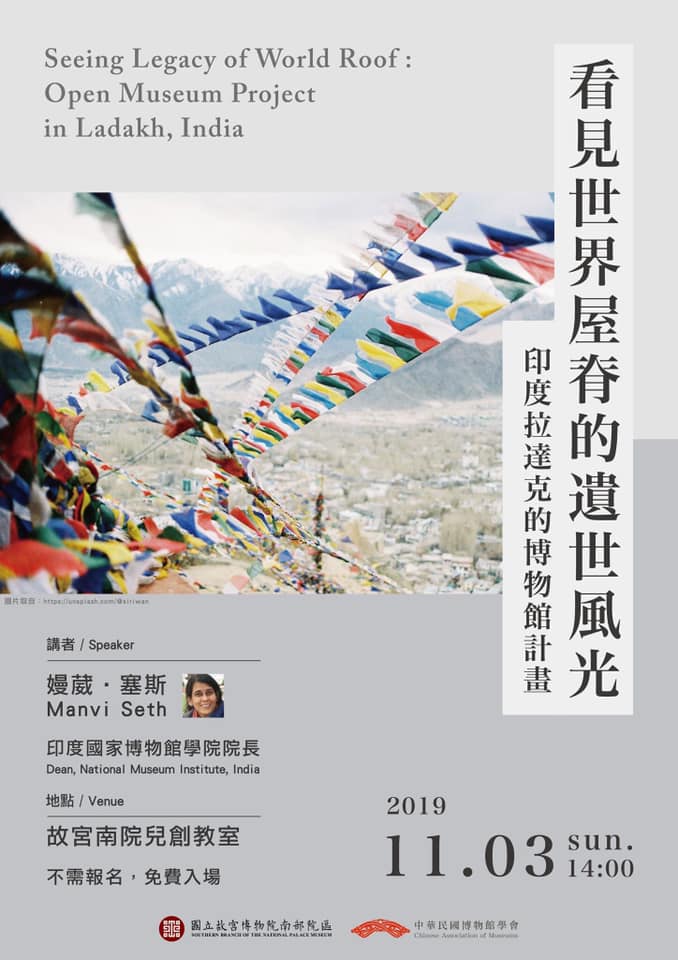【看見世界屋脊的遺世風光—印度拉達克的博物館計畫
Seeing Legacy of World Roof: Open Museum Project in Ladakh, India】
❉ 活動內容
還記得印度寶萊塢電影《三個傻瓜》(3 Idiots)男女主角重逢的蔚藍湖畔嗎?
拍攝地點正是在印度拉達克的班公錯湖,擁有壯闊山川風光的拉達克到底是一個什麼樣的地方呢?
拉達克(Ladakh)位於印度北方邊境、喜馬拉雅山南麓,與中國西藏、巴基斯坦接壤,海拔在3000-7000公尺之間,是地球上最高的人類活動地區,主要人口為藏族和印度亞利安人,其文化在過去幾百年來一直與世隔絕。該地區的自然和文化遺產獨特、社區緊密相連,不斷增長的遊客和大量資訊在主要城市列城(Leh)帶動了豐富的文化融合。
近年來,在地逐漸意識到保存文化傳統及平衡現代需求的必要性,希望在列城建立一座博物館,展示拉達克文化的各個面相。目前拉達克有許多寺廟,身兼博物館的角色,展示當地的藏傳佛教藝術和文化。
預計在列城成立的博物館希望以有形和無形的方式,蒐集、記錄和再現拉達克遺產、生活和文化,並成為一處平台,不僅保存實體典藏,還能聯繫年輕世代與他們的認同意識,促進當前與文化相關議題的對話,並為理解和引導未來的文化變革提供一套溝通機制。
而拉達克有什麼樣獨特的歷史、藝術與文化遺產?博物館如何記錄和再現當地的文化?在社區居民的參與下,博物館發展出什麼樣的形式、性質、特徵和功能?讓我們一起攀上世界屋脊,看見拉達克的遺世風光。
❉ 講者簡介
嫚葳‧塞斯(Manvi Seth)教授現任印度國家博物館學院院長,並擔任該學院的博物館學系教授兼系主任。同時也是國際博物館文獻委員會(CIDOC)非物質文化遺產工作小組的主席。2000至2002年間,曾擔任印度齋浦爾城市宮殿Maharaja Sawai Man Singh II博物館的裝飾藝術策展人。博物館參訪足跡遍布印度、英國、美國、智利、德國及澳洲。參與的研究計畫領域包含:觀眾研究、博物館教育和文獻(非物質文化遺產)。
❉ 講者
嫚葳‧塞斯 Manvi Seth(印度國家博物館學院院長)
❉ 時間
2019年11月3日(週日)下午14:00-16:00
❉ 地點
國立故宮博物院南部院區 兒創教室
• 英語演講,提供華語翻譯
• 不需報名,免費入場
–
Lecture Abstract:
Remember the pure blue lake in the Indian Bollywood movie “3 Idiots” where the male and female actors reunited? The shooting location is in Pangong Tso Lake, Ladakh, India. What kind of place is Ladakh with such magnificent scenery?
Ladakh is located on the northern border of India and southern Himalayas. It borders China’s Tibet and Pakistan, and is between 3,000 and 7,000 meters above sea level. It is one of the highest inhabited places on earth.
The main population is Tibetan and Indian Aryan, with a culture that remained isolated for centuries. The heritage, natural and cultural, of the region is unique, the community is close knit, and the rich culture is ruffled by the ever-growing avalanche of tourists and the information explosion only in the main city, Leh.
There is a growing realization of the need to preserve cultural traditions alongside balancing the pressures of modern needs. In recent years there has been an increasing insistence in Ladakh that there should be a museum in Leh showcasing all aspects of Ladakhi culture. There are many monasteries in Ladakh that serve as museums on Buddhist religion, art, and culture.
The projected museum in Leh aspires to collect, document, and represent all aspects of a Ladakhi heritage, life, and culture in their tangible and intangible manifestations. It seeks to become a platform not merely for preserving physical collections but for connecting the younger generation with their own identity, for stimulating dialogue on the present issues concerning culture, and for providing a mechanism for understanding and channeling the future course of cultural change.
What are the unique history, art and cultural heritage in Ladakh? How does the museum document and represent local culture? What form, nature, characteristics and functions have the museum developed with the participation of the community? Let’s climb up world roof and see the legacy of Ladakh.
About the Speaker:
Prof. (Dr) Manvi Seth is currently Dean, National Museum Institute and Professor and Head in the Department of Museology, National Museum Institute. She is the Chair, Intangible Cultural Heritage Working Group, CIDOC. Prior to this, she worked as Curator for Decorative Arts at Maharaja Sawai Man Singh II Museum, City Palace, Jaipur from 2000 to 2002. She has visited museums across India, UK, US, Chile, Brazil, Germany and Austria. She has conceptualized and coordinated research projects in the areas of Visitor Studies, Museum Education and Documentation (Intangible Cultural Heritage).
國立故宮博物院(http://www.npm.gov.tw)
開放時間:全年開放,8:30-18:30
夜間延長開放時段:每週五、週六18:30~21:00,國人憑身分證件可免費參觀。
館址:111台北市士林區至善路二段221號
服務電話:(02)2881-2021

